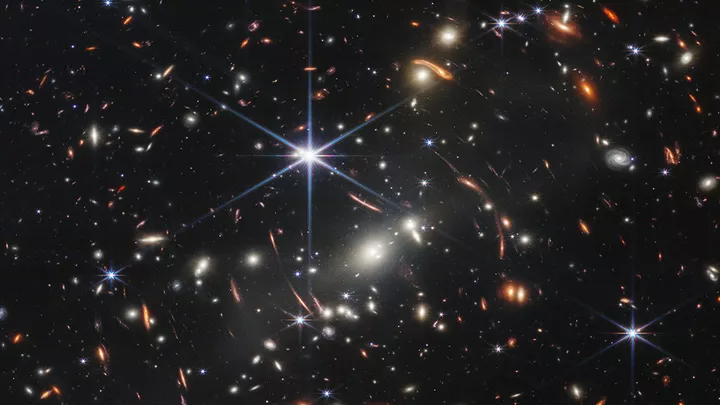
How did the Big Bang really happen? How far does the universe really extend? Are humans alone in the universe?
In the not-too-distant future, the Hubble Telescope's successor, the James Webb Space Telescope (JWST), may answer these questions, now that it has delivered its first answer.
JWST has captured the deepest, sharpest infrared image of the distant universe to date, and the first full-color image since it entered service.
Infrared imaging as an eye to the unknown ancient universe
The picture shows the galaxy cluster SMACS 0723, which appeared 4.6 billion years ago and contains thousands of galaxies.
It was taken by JWST's Near Infrared Camera (NIRCam), composited with photos at different wavelengths, and took a total of 12.5 hours to collect all the photos, which would have taken weeks if it had been given to the Hubble Telescope.
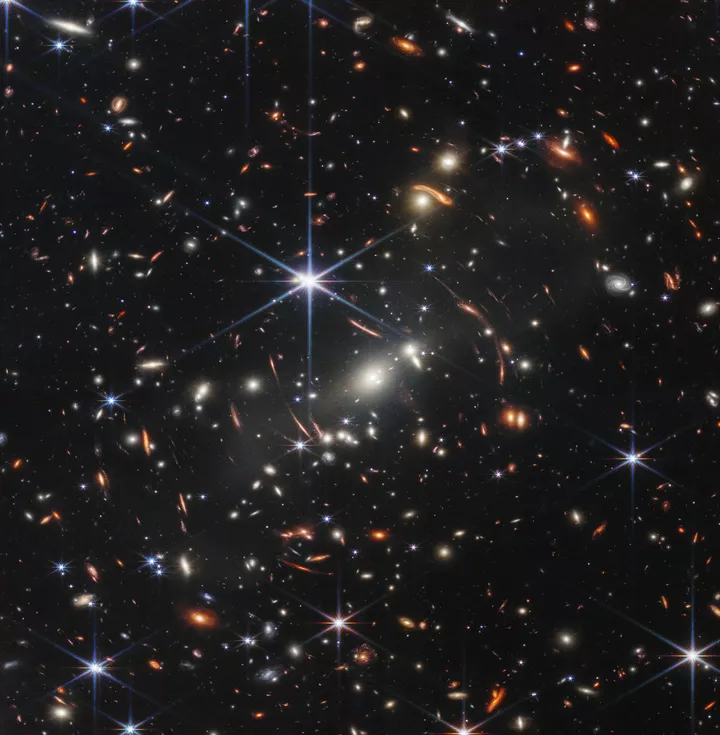
▲ Image from: NASA
NASA Administrator Bill Nelson released this photo during a special last-minute briefing at the White House on the afternoon of July 11 EST.
Mr. President, if you put a grain of sand on your fingertip an arm's length away, that's part of the universe you're looking at.
But the clusters in the diagram are so massive that they even bend space and time around them, resulting in a 'gravitational lensing' phenomenon that magnifies the more distant galaxies behind the clusters.
The light from some of these galaxies in the diagram has traveled 13 billion years to reach the telescope in front of them.
JWST will not only image the target object, but also decompose the light into different wavelengths.
Thus, JWST can not only focus on distant nebulae, galaxy clusters, and even exoplanets, allowing us to see tiny structures never seen before, but also help researchers understand the mass, age, history, and composition of galaxies.

▲ Image from: NASA
This is mainly because, unlike telescopes such as Hubble, JWST is based on infrared imaging, observing light emitted in the region of the electromagnetic spectrum (the infrared region) that is not visible to the human eye.
The four scientific instruments that play a role are the Near Infrared Spectrometer (NIRSpec), the Mid-Infrared Instrument (MIRI), the Near Infrared Camera (NIRCam), the Near Infrared Imager and the Seamless Spectrograph (NIRISS).
Hubble has partial IR detection capability, but not as good as JWST.
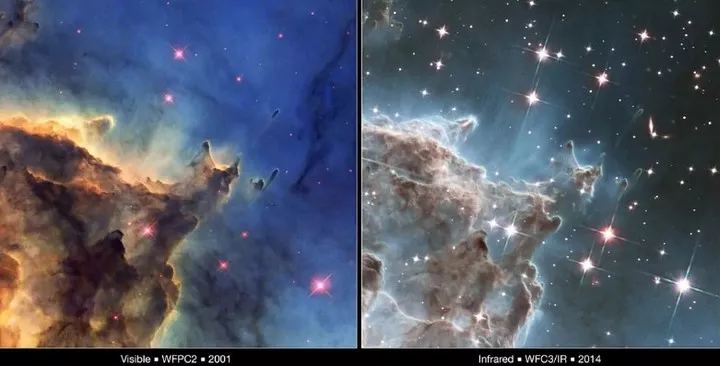
▲ Visible (left) and infrared views (right) of Hubble's observation of the Monkey Nebula. Image from: NASA and ESA
JWST observations of the infrared region, essential for mapping the timeline of our universe - As the universe is expanding, the oldest and rarest stars, and the things illuminated by them, will only appear to us as infrared light.
Astronomers hope to use JWST to explore every stage of the universe's history, from the interior of our solar system to the most distant observable galaxies in the early universe and everything in between, helping humanity understand the origin of the universe, the evolution of galaxies, and our place in it.
That is, we can expect to observe the early state of the visible universe today, see the first galaxies that formed only a few hundred million years after the Big Bang, and revolutionize astrophysics as we know it.
This photo is just a teaser, and on July 12 at 22:30 GMT, NASA will release more full-color images and data live, including nebulae, galaxies, and extrasolar planetary atmospheres.
The most expensive space telescope ever built, no room for error
JWST was launched on December 25, 2021, after some 25 years of development.
It followed decades of preparation, with plans beginning in the early 1990s, named after NASA's second Administrator James Webb, with a budget of $500 million, to be operational in 2007.
However, the JWST was far more difficult to build than NASA had anticipated, and due to numerous engineering delays and cost overruns, the JWST underwent a major redesign in 2005, delaying launch until JWST finally became possible in 2021.
A 25-year investment by 20 countries, tens of thousands of scientists, setbacks and multiple delays have resulted in the most expensive space telescope ever built, JWST costing nearly $10 billion.
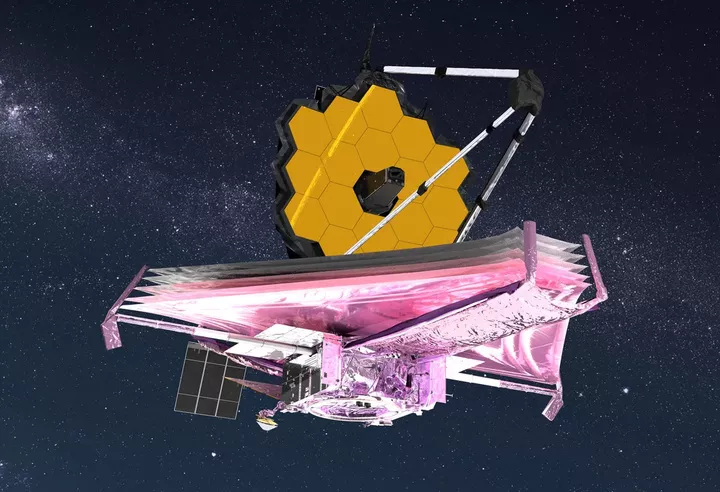
▲ Fully expanded JWST (art rendering). Image from: NASA
Frontier science burns money, naturally, and it includes lenses with larger apertures, mirror materials at the 10-nanometer level, sun shades the size of tennis courts, and more, many of which are 'orphaned' items that are available and only available and must be 100% correct.
In short, the technology is groundbreaking, the R&D is desperate, and the costs are never simply linear in growth.
Even if it could be launched, the JWST is too large to be launched directly into space in its full form, it would have to be folded up to be mounted on a rocket for launch, and only after launch could all adjustments be made in the far reaches of space, with no room for error.
It took two weeks just to unfold the visor in space.
The temperature of the JWST observing assembly must be kept below 40K (-233.15°C) for the faint infrared light to be visible, and the sunshade acts as a temperature control device. Otherwise, the signal from the observing target would be drowned out by the infrared radiation from the telescope itself, the Sun, and the Earth and Moon.

▲ Sun visor undergoes ground tests before launch. Image from: NASA
The complexity of unfolding the visor is reflected in the fact that each joint must be perfectly executed for the visor to be opened. There are as many as 344 single points of failure throughout the JWST, and the visor contains a large portion of these, and a single point of failure means that if a failure occurs, then the entire project is declared a failure. an unexpected tear in the film during testing in 2018 was also a factor in the project's delay.
The calibration of the primary mirror was equally time consuming.
The JWST's primary mirror, designed as a 'honeycomb' collapsible reflector consisting of 18 hexagonal lenses, helps it capture a large amount of infrared light from its chosen target. But each of these lenses (plus the secondary mirror and other components) needs to be precisely adjusted so that the images reflected in them match and overlap with the other mirrors.
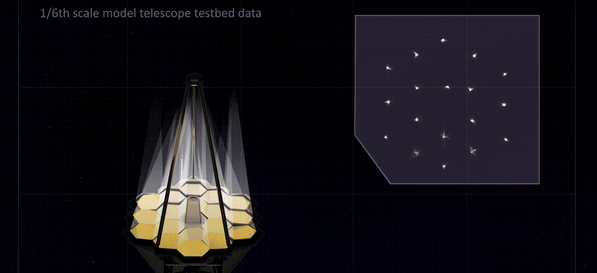
▲ Action figure made from: YouTube @JWST
For the past six months, engineers and scientists have been carefully adjusting the mirror section of the telescope and calibrating its instruments.
Now, JWST is finally ready to do everything and start collecting light from distant galaxies for humanity.